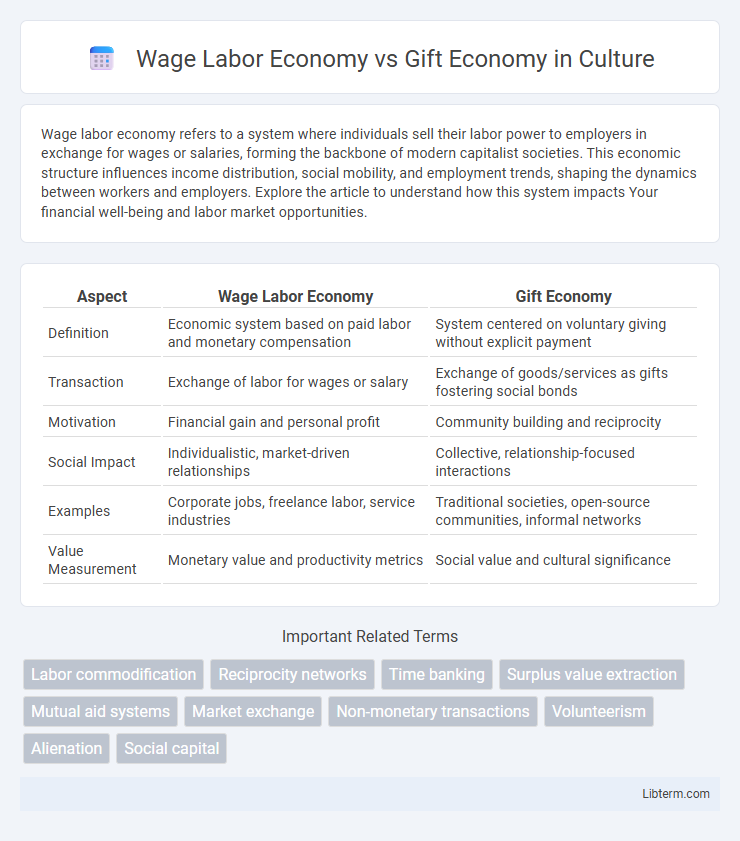Wage labor economy refers to a system where individuals sell their labor power to employers in exchange for wages or salaries, forming the backbone of modern capitalist societies. This economic structure influences income distribution, social mobility, and employment trends, shaping the dynamics between workers and employers. Explore the article to understand how this system impacts Your financial well-being and labor market opportunities.
Table of Comparison
| Aspect | Wage Labor Economy | Gift Economy |
|---|---|---|
| Definition | Economic system based on paid labor and monetary compensation | System centered on voluntary giving without explicit payment |
| Transaction | Exchange of labor for wages or salary | Exchange of goods/services as gifts fostering social bonds |
| Motivation | Financial gain and personal profit | Community building and reciprocity |
| Social Impact | Individualistic, market-driven relationships | Collective, relationship-focused interactions |
| Examples | Corporate jobs, freelance labor, service industries | Traditional societies, open-source communities, informal networks |
| Value Measurement | Monetary value and productivity metrics | Social value and cultural significance |
Introduction to Wage Labor and Gift Economies
Wage labor economies operate on monetary compensation where workers exchange their labor for fixed wages, emphasizing productivity and market-driven transactions. Gift economies rely on voluntary exchange without direct remuneration, fostering social bonds and communal reciprocity through sharing and mutual aid. Understanding these distinct economic systems highlights contrasting motivations and social dynamics shaping economic interactions globally.
Historical Evolution of Economic Systems
The historical evolution of economic systems highlights a transition from gift economies, where resource exchange relied on social bonds and reciprocity within tribes or kinship groups, to wage labor economies characterized by formalized employment contracts and monetary compensation. Gift economies predominated in prehistoric and early agricultural societies, facilitating cooperation and social cohesion without standardized currency. The rise of industrialization and market-based economies in the 18th and 19th centuries propelled wage labor economies to dominance, fostering labor specialization, capital accumulation, and large-scale production.
Core Principles of Wage Labor Economy
The core principles of a wage labor economy revolve around the exchange of labor for monetary compensation, where workers sell their labor power to employers under contractual agreements. This system emphasizes market-driven supply and demand dynamics, private ownership of production means, and the commodification of labor as a tradable asset. Efficiency, productivity, and profit maximization are central, with labor contracts regulating work hours, wages, and conditions within a competitive labor market.
Core Principles of Gift Economy
Gift economies operate on principles of reciprocity, community trust, and mutual aid, where goods and services are exchanged without explicit agreements or monetary compensation. Unlike the wage labor economy, which relies on contractual labor and commodified time, gift economies emphasize social bonds and long-term relationships as the foundation of economic interactions. This system fosters cooperation and shared responsibility, reducing competition and promoting communal well-being over individual profit.
Key Differences Between Wage Labor and Gift Economies
Wage labor economies operate on monetary compensation for work performed, emphasizing individual productivity, market-driven transactions, and contractual agreements. Gift economies rely on reciprocal generosity, social bonds, and community trust, where goods and services are exchanged without explicit agreements or immediate returns. The key differences center on the motivations for exchange, with wage labor prioritizing economic incentives and gift economies fostering communal relationships and mutual aid.
Social and Cultural Impacts
Wage labor economies emphasize individual productivity and monetary compensation, fostering competition and shaping social hierarchies based on income disparities. Gift economies prioritize reciprocity and communal sharing, strengthening social bonds and cultural values centered on trust and cooperation. The contrast between these systems influences societal norms, with wage labor promoting economic individualism and gift economies enhancing collective identity and mutual support networks.
Economic Efficiency and Productivity Comparison
Wage labor economies emphasize economic efficiency through standardized labor contracts, enabling clear productivity metrics and incentivized output, which drives scalable industrial growth. Gift economies rely on social reciprocity and communal sharing, often resulting in variable productivity and informal resource distribution that may limit large-scale efficiency but enhance social cohesion. Comparative analysis reveals wage labor systems optimize for quantifiable productivity, while gift economies prioritize relational capital, impacting measured economic efficiency differently across contexts.
Challenges and Criticisms of Each System
Wage labor economies face challenges such as income inequality, job insecurity, and exploitation, where workers often lack control over production and face limited bargaining power. Gift economies encounter criticisms related to scalability, reliance on reciprocity, and potential for free-riding, which can undermine resource distribution and social cohesion. Both systems struggle to balance efficiency, fairness, and sustainability in meeting the needs of diverse populations.
Modern Examples and Case Studies
Modern wage labor economies dominate urban centers globally, with prominent examples in manufacturing hubs like Shenzhen, where workers earn fixed salaries under contractual agreements. Contrastingly, gift economies thrive in digital communities such as open-source software development, exemplified by Linux contributors who share code freely without direct monetary compensation. Case studies reveal how platforms like Wikipedia operate on gift economy principles, relying on voluntary knowledge sharing rather than wage labor incentives.
Future Prospects: Blending Economies or Diverging Paths
Future prospects of the wage labor economy and gift economy reveal potential for blending hybrid models that integrate monetary compensation with community-based reciprocity, fostering sustainable and equitable wealth distribution. Innovations in decentralized technologies and cooperative platforms enable new economic structures that challenge traditional labor wage hierarchies by embedding trust and social capital into transactions. However, diverging paths remain plausible as global economic disparities and cultural differences influence the adoption and scalability of gift economy principles alongside established market-driven wage labor systems.
Wage Labor Economy Infographic

 libterm.com
libterm.com